View in other NatureServe Network Field Guides
NatureServe
Montana
Utah
Wyoming
Idaho
Wisconsin
British Columbia
South Carolina
Yukon
California
New York
Small-flowered Pennycress - Noccaea parviflora
Other Names:
Thlaspi parviflorum
State Rank Reason (see State Rank above)
Noccaea parviflora is a regional endemic, known in Montana from several southwestern counties. It is a small, short-lived plant that likely requires some disturbance to maintain its habitat.
- Details on Status Ranking and Review
Population Size
Score1-2 - Small to Moderate. Population size is imprecisely known but is believed to be >2,000 individuals and <100,000 individuals.
Range Extent
Score2 - Regional or State Endemic or Small Montana Range: Generally restricted to an area <100,000 sq. miles (equivalent to 2/3 the size of Montana or less) or Montana contributes 50% or more of the species’ range or populations OR limited to 2-3 Sub-basins in Montana.
Area of Occupancy
Score1 - Moderate: Generally occurring in 11-25 Subwatersheds (6th Code HUC’s).
Environmental Specificity
Score1 - Moderate: Species is restricted to a specific habitat that is more widely distributed or to several restricted habitats and is typically dependent upon relatively unaltered, good-quality habitat (C Values of 5-7).
Trends
ScoreNA - Rank factor not assessed.
Threats
Score0-1 - Low to Medium.
Intrinsic Vulnerability
Score1 - Moderate Vulnerability: Specific biological attributes, unusual life history characteristics or limited reproductive potential makes the species susceptible to extirpation from stochastic events or other adverse impacts to its habitat and slow to recover.
Raw Conservation Status Score
Score
6 to 8 total points scored out of a possible 16 (Rarity factors and threats only).
General Description
Noccaea parviflora is a taprooted biennial or short-lived perennial that reaches 1-3 dm in height and is often branched above the middle of the stem. The foliage is glabrous and glaucous, and basal leaves are 5-15 mm long with a slender stalk and narrowly elliptic blades that are sometimes toothed. Stems leaves are sessile and clasp the stem. Flowers are borne on short, nearly horizontal stalks in a narrow inflorescence that elongates as the fruits mature. The four white petals are 2-3 mm long, and the four green sepals 1-1.5 mm long. The oblanceolate, flattened fruits are 5-7 mm long, with a style up of to 0.5 mm.
Phenology
Plants flower in late June and early July, and fruit matures in August.
Diagnostic Characteristics
Noccaea parviflora is similar to the more common N. fendleri. However, the latter has longer sepals and petals, and the style in fruit is at least 1 mm long.
Species Range
Montana Range
Range Descriptions

 Native
Native
Range Comments
Central Idaho, northwestern Wyoming (Absarokas, Wind Rivers, and southwestern Bighorns, greater Yellowstone area), and Montana. Regional endemic (MTNHP 1999; Walt Fertig, personal communication 1999).
Observations in Montana Natural Heritage Program Database
Number of Observations: 42
(Click on the following maps and charts to see full sized version)
Map Help and Descriptions
Relative Density
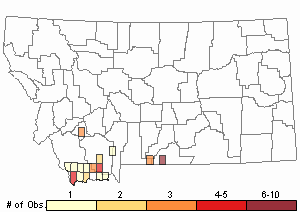
Recency
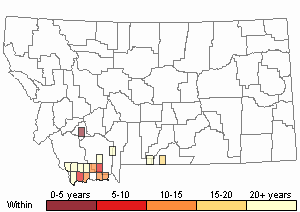
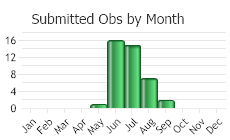
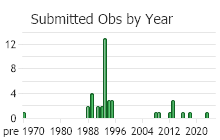
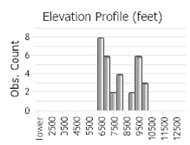 (Observations spanning multiple months or years are excluded from time charts)
(Observations spanning multiple months or years are excluded from time charts)
Habitat
Noccaea parviflora is found in north-central Wyoming, east-central Idaho and southwest Montana. In Montana it is known from Beaverhead, Carbon, Madison, Park and Silver Bow counties, where it is found from mid-elevation grasslands to alpine turf (6,500 to 10,000 feet). It most often inhabits sagebrush steppe dominated by Artemisia tridentata ssp. vaseyana and Festuca idahoensis. Several moisture-loving species, such as Juncus balticus and Potentilla fruticosa, are often also present in these habitats. Noccaea parviflora has also been found occasionally in alpine turf communities, ranging from moist habitats dominated by Deschampsia cespitosa and Carex scirpoidea to drier sites supporting Carex elynoides.
National Vegetation Classification System Groups Associated with this Species
Alpine
Alpine - Vegetated
Shrubland
Sagebrush Shrubland
Grassland
Montane - Subalpine Grassland
Wetland and Riparian
Alpine Riparian and Wetland
Wet Meadow and Marsh
Ecology
Noccaea parviflora is a short-lived plant, smaller than the dominant species in most habitats where it occurs. It flowers early and is often found in open microsites between shrubs or bunchgrasses. Given its growth form and habitat, it may be expected to respond positively to disturbances such as moderate grazing or fire that opens the canopy.
Management
Fire and grazing are two important forces affecting small-flowered pennycress habitat. Disturbance from fire reduces competition from sagebrush and large bunchgrasses and likely enhances population viability for Noccaea parviflora. Livestock grazing generally favors broad-leaved forbs at the expense of graminoids. Noccaea parviflora is a very small plant likely to benefit from removal of the dominant grass canopy. Nearly all known Montana populations of N. parviflora are on public land, primarily managed by the U.S. Forest Service. Most of these sites are subject to livestock grazing.
Stewardship Responsibility
References
- Additional ReferencesLegend:
 View Online Publication
View Online Publication
Do you know of a citation we're missing? Aho, Ken Andrew. 2006. Alpine and Cliff Ecosystems in the North-Central Rocky Mountains. Ph.D. Dissertation. Bozeman, Montana: Montana State University. 343 p.
Aho, Ken Andrew. 2006. Alpine and Cliff Ecosystems in the North-Central Rocky Mountains. Ph.D. Dissertation. Bozeman, Montana: Montana State University. 343 p. Culver, D.R. 1994. Floristic analysis of the Centennial Region, Montana. M.Sc. Thesis. Montana State University, Bozeman. 199 pp.
Culver, D.R. 1994. Floristic analysis of the Centennial Region, Montana. M.Sc. Thesis. Montana State University, Bozeman. 199 pp. Lesica, P. 1992. Vascular plant and sensitive plant species inventory for the Highland Mountains, Deerlodge National Forest. Unpublished report prepared for the Deerlodge National Forest. Montana Natural Heritage Program, Helena, MT. 21 pp. plus appendices, photographs.
Lesica, P. 1992. Vascular plant and sensitive plant species inventory for the Highland Mountains, Deerlodge National Forest. Unpublished report prepared for the Deerlodge National Forest. Montana Natural Heritage Program, Helena, MT. 21 pp. plus appendices, photographs. Lesica, P. 1993. Vegetation and flora of the Line Creek Plateau area, Carbon County, Montana. Unpublished report to USDA Forest Service, Intermountain Research Station. Montana Natural Heritage Program, Helena, Montana. 30 pp.
Lesica, P. 1993. Vegetation and flora of the Line Creek Plateau area, Carbon County, Montana. Unpublished report to USDA Forest Service, Intermountain Research Station. Montana Natural Heritage Program, Helena, Montana. 30 pp. Lesica, P. and J. Vanderhorst. 1995. Sensitive plant survey of the Sage Creek area, Beaverhead County, Montana, Dillon Resource Area, Bureau of Land Management. Unpublished report to the Bureau of Land Management. Montana Natural Heritage Program. 36 pp. plus appendices.
Lesica, P. and J. Vanderhorst. 1995. Sensitive plant survey of the Sage Creek area, Beaverhead County, Montana, Dillon Resource Area, Bureau of Land Management. Unpublished report to the Bureau of Land Management. Montana Natural Heritage Program. 36 pp. plus appendices. Lesica, P., M.T. Lavin, and P.F. Stickney. 2012. Manual of Montana Vascular Plants. Fort Worth, TX: BRIT Press. viii + 771 p.
Lesica, P., M.T. Lavin, and P.F. Stickney. 2012. Manual of Montana Vascular Plants. Fort Worth, TX: BRIT Press. viii + 771 p. Lesica, P., M.T. Lavin, and P.F. Stickney. 2022. Manual of Montana Vascular Plants, Second Edition. Fort Worth, TX: BRIT Press. viii + 779 p.
Lesica, P., M.T. Lavin, and P.F. Stickney. 2022. Manual of Montana Vascular Plants, Second Edition. Fort Worth, TX: BRIT Press. viii + 779 p. Rollins, R. C. 1993. The Cruciferae of Continental North America: systematics of the mustard family from the Arctic to Panama. Stanford University Press, Stanford, California. 976 pp.
Rollins, R. C. 1993. The Cruciferae of Continental North America: systematics of the mustard family from the Arctic to Panama. Stanford University Press, Stanford, California. 976 pp. Vanderhorst, J.P. and P. Lesica. 1995a. Sensitive plant survey of the Tendoy Mountains in the Beaverhead National Forest, Beaverhead County, Montana. Unpublished report to the Bureau of Land Management, Butte District. Montana Natural Heritage Program, Helena, MT. 59 pp. plus appendices.
Vanderhorst, J.P. and P. Lesica. 1995a. Sensitive plant survey of the Tendoy Mountains in the Beaverhead National Forest, Beaverhead County, Montana. Unpublished report to the Bureau of Land Management, Butte District. Montana Natural Heritage Program, Helena, MT. 59 pp. plus appendices.
- Web Search Engines for Articles on "Small-flowered Pennycress"





